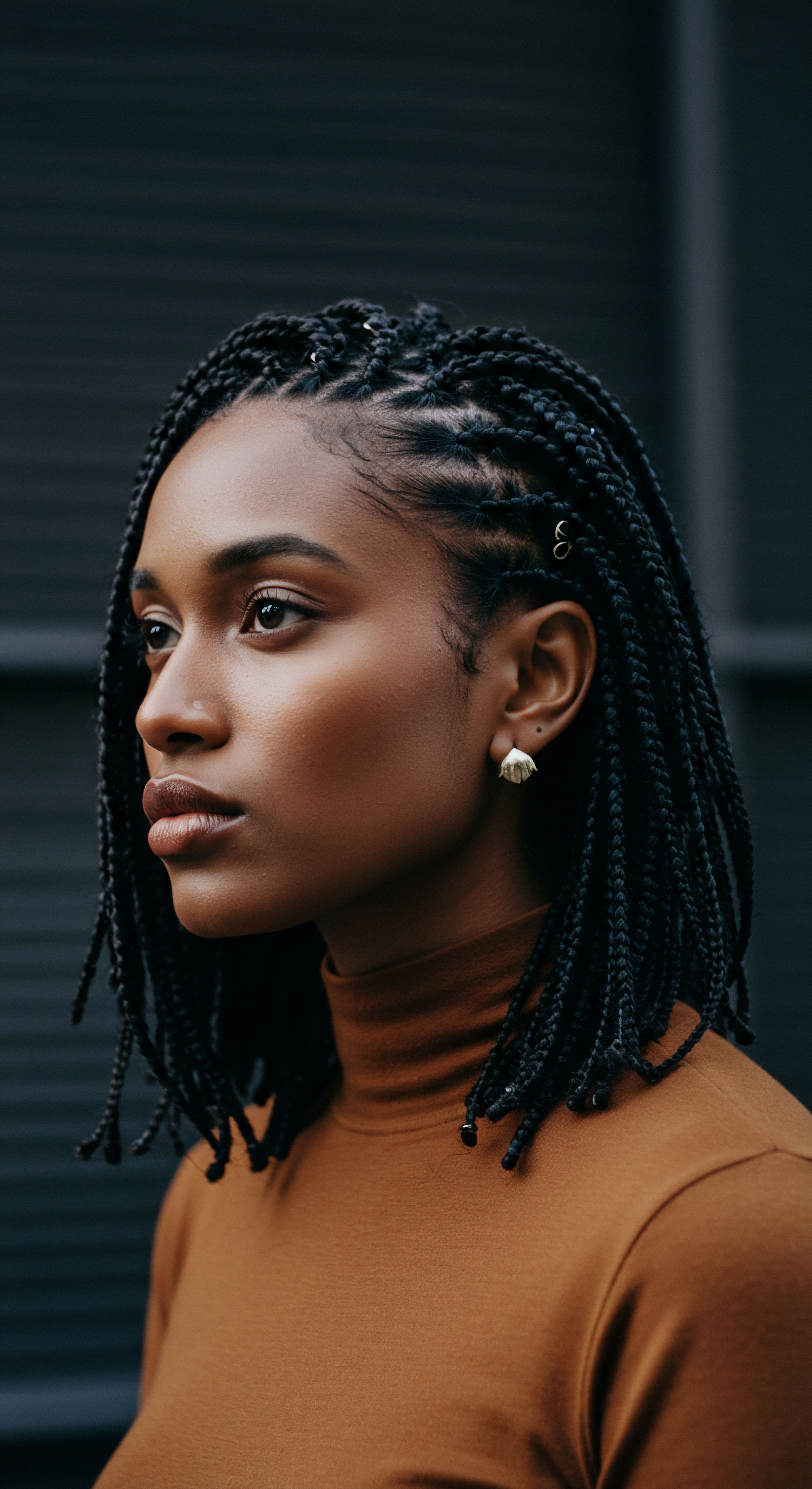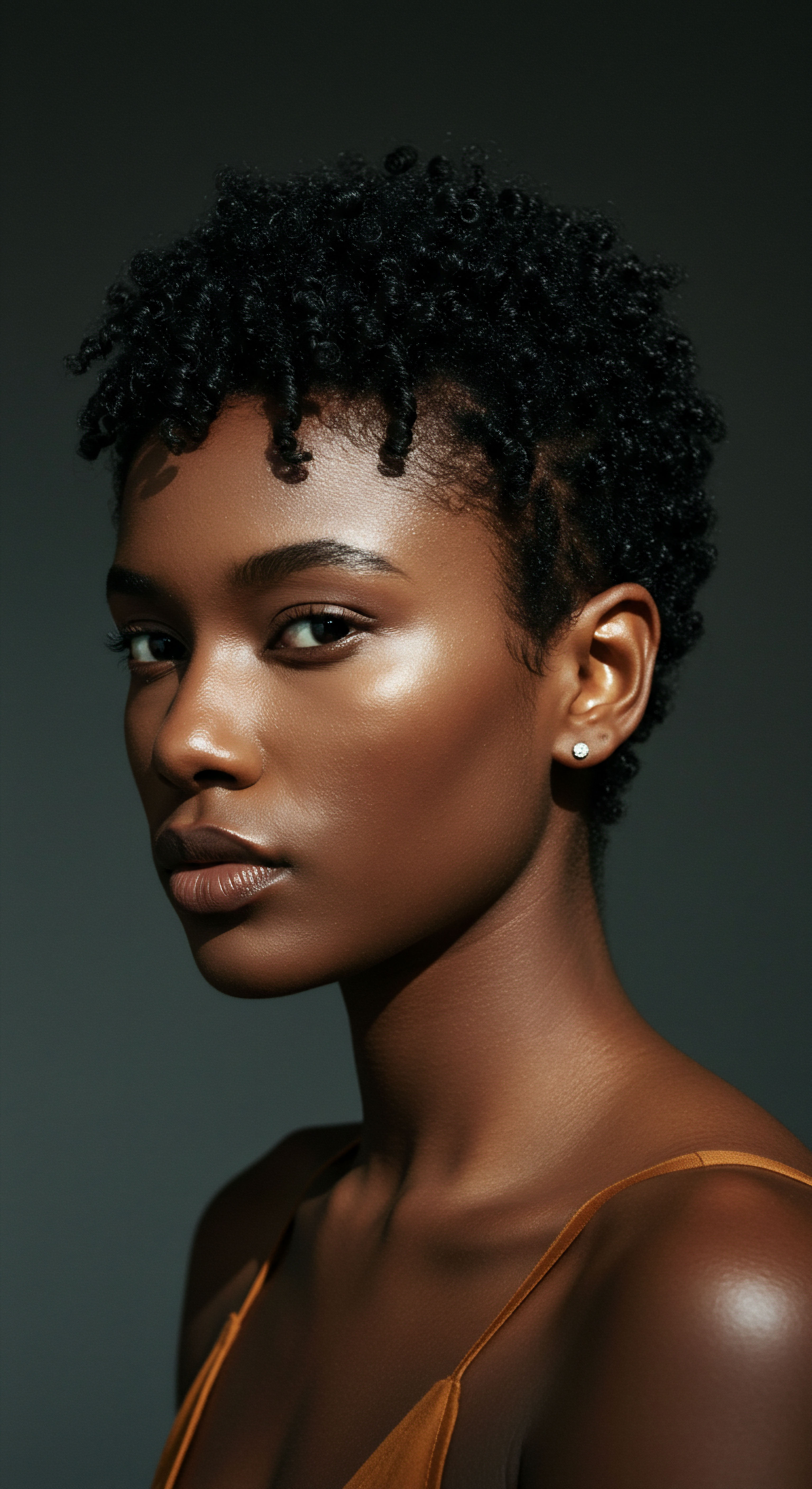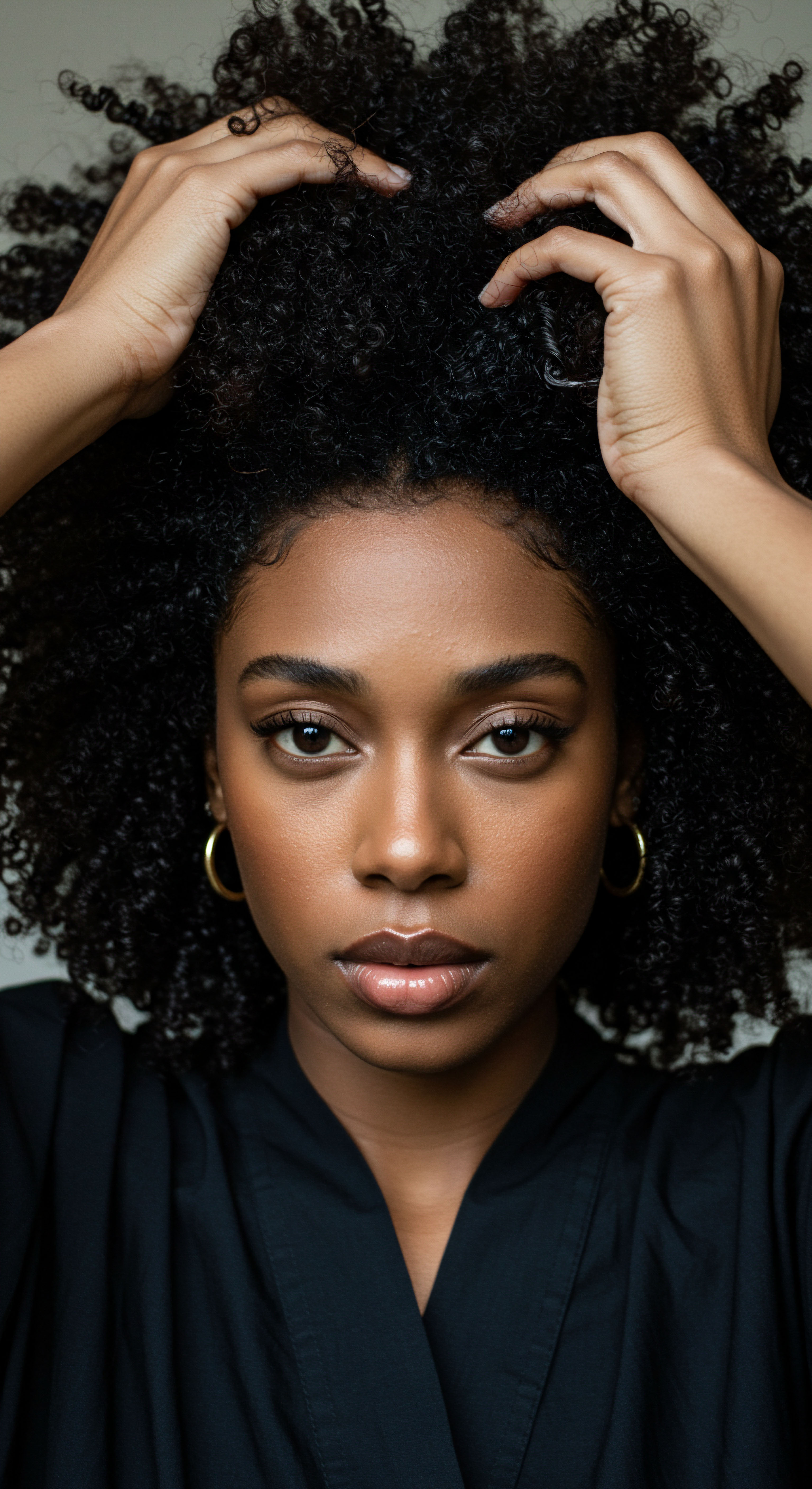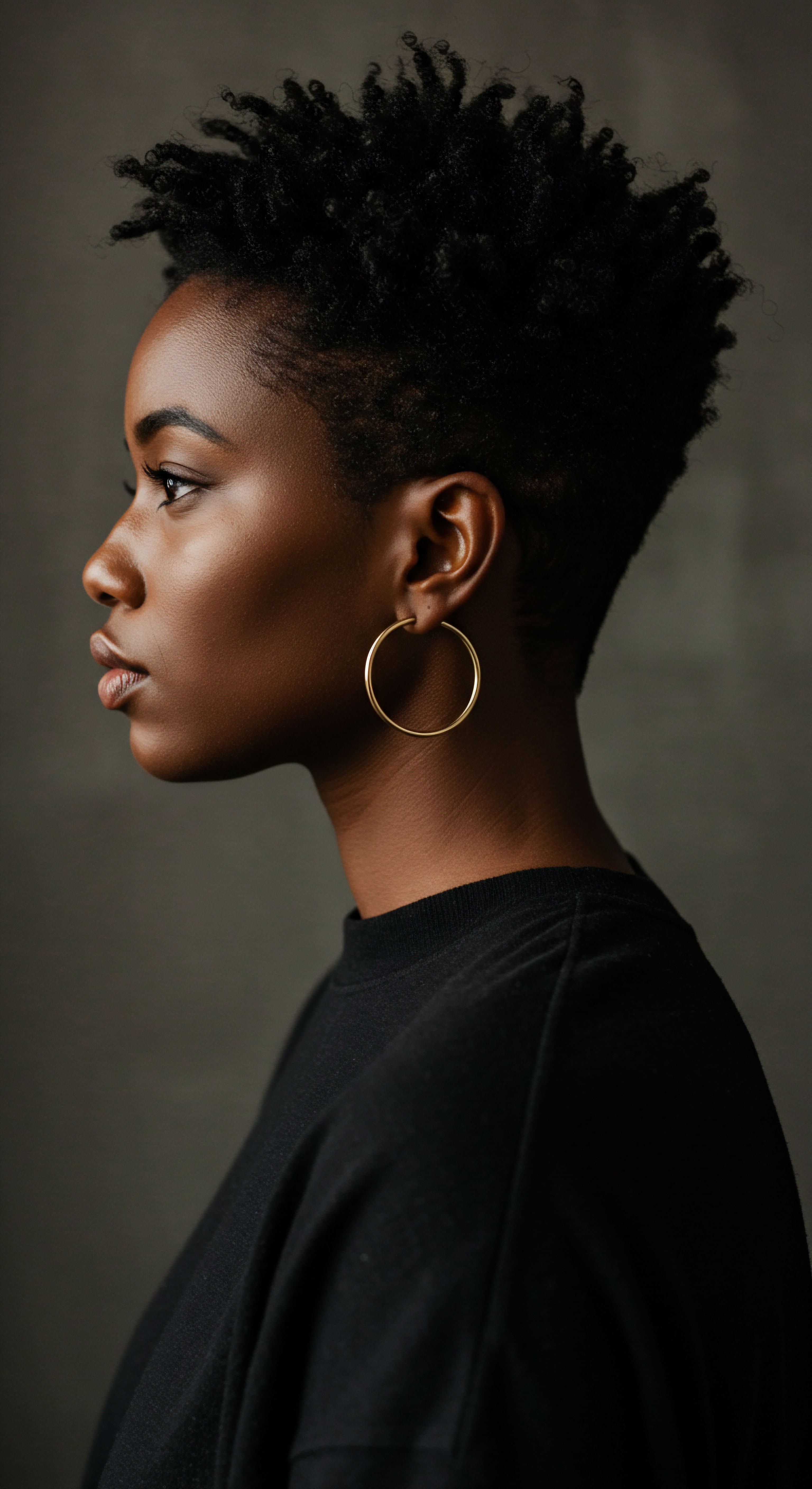
Roots
Have you ever awakened after a night of truly restorative rest, a sleep so profound it felt like a gentle tide washing over you, and noticed a subtle shift in your hair? Perhaps a softness, a quiet sheen, a renewed spring in its coils or waves that was not quite there before? This quiet observation, often dismissed as mere coincidence, holds a whisper of a deeper truth. Our hair, a vibrant extension of our very being, does not exist in isolation from the rhythms of our bodies.
It is a living, breathing part of us, deeply attuned to our internal symphony, and nowhere is this connection more profound than in the realm of sleep. To truly comprehend the way slumber shapes the vitality of our strands, we must first descend to the cellular level, understanding the intricate dance of life and regeneration that unfolds within the hair follicle itself, a process intimately orchestrated by the silent hours of night.

The Hair Follicle’s Nocturnal Life
At the base of every strand of hair lies the follicle, a miniature organ bustling with activity. This tiny powerhouse is a hub of cellular division and metabolic processes, responsible for the creation of hair. The cells within the hair bulb are among the fastest dividing cells in the human body, a relentless pace that requires a steady supply of energy and raw materials. During waking hours, our bodies are often occupied with the demands of daily life, diverting resources to muscles, brains, and other active systems.
Night, however, ushers in a different kind of labor. It is a time for repair, replenishment, and growth across all bodily systems, including those responsible for hair generation.
The intricate choreography of hair growth unfolds in distinct phases, a cycle that is surprisingly susceptible to disruptions in our nightly repose.
- Anagen ❉ This is the active growth phase, where hair cells divide rapidly, pushing the hair shaft upwards. For scalp hair, this phase can last several years.
- Catagen ❉ A brief transitional phase, lasting a few weeks, where hair growth ceases and the follicle shrinks.
- Telogen ❉ The resting phase, typically lasting a few months, during which the hair remains in the follicle but is not growing. A new hair begins to form beneath it.
- Exogen ❉ The shedding phase, often considered a part of telogen, where the old hair is released and falls out.
When sleep is consistently poor, this delicate cycle can be thrown into disarray. The body, perceiving a state of stress or insufficient recovery, may prematurely shunt a higher percentage of hair follicles into the telogen, or resting, phase. This phenomenon, known as Telogen Effluvium, can lead to noticeable thinning and shedding, a clear physical manifestation of internal imbalance. The cascade begins with the follicle’s inability to receive the sustained energetic support and hormonal signals it needs for robust anagen phase maintenance.

The Body’s Restorative Chemistry at Night
The darkness and quiet of night are not merely an absence of light and sound; they are potent signals for the body to initiate a cascade of restorative chemical processes. Melatonin, often thought of solely as the sleep hormone, also acts as a powerful antioxidant and plays a role in regulating the hair growth cycle. Its presence during sleep helps to shield hair follicles from oxidative stress, which can damage cells and impede healthy growth. Beyond melatonin, deep sleep is the primary window for the release of human growth hormone (HGH), a vital player in cellular regeneration and repair throughout the body, including the skin and hair follicles.
A lack of consistent, deep sleep can depress HGH secretion, leaving the scalp and follicles without the necessary repair mechanisms. Think of it as a nightly renovation project for your body; without enough time or the right conditions, the work simply cannot be completed. The cells that form your hair, your scalp, and the delicate network of blood vessels that feed them, rely on these nocturnal chemical ballets for their ongoing health and ability to regenerate. Without them, the very foundation of hair vitality begins to weaken.
Hair vitality is profoundly linked to the body’s nightly restorative processes, particularly the delicate balance of hormones and cellular repair mechanisms active during sleep.

The Impact of Circadian Rhythms on Follicular Activity
Beyond individual hormones, the entire human system operates on a 24-hour cycle known as the circadian rhythm. This internal clock governs not only our sleep-wake patterns but also a myriad of physiological processes, including cell division, hormone secretion, and even the activity of specific genes. Recent scientific exploration has revealed that hair follicles possess their own intrinsic circadian clocks, meaning their cellular activities are also timed to this daily rhythm.
Disruptions to this finely tuned internal timing, such as those caused by irregular sleep schedules, shift work, or chronic sleep deprivation, can have direct repercussions on hair follicle function. A study published in Cell Reports in 2021 by Wang et al. explored the impact of circadian rhythm disruption on hair follicle stem cell activity and hair growth in mice. The research found that when the circadian clock was disrupted, it impaired the normal function of hair follicle stem cells, leading to a decrease in hair growth.
This suggests that the timing of sleep, not just its duration, could be a critical factor in maintaining the hair follicle’s optimal performance and ability to regenerate. The very cellular machinery responsible for hair production seems to be most active and receptive during specific windows of our sleep cycle.
| Hair Phase Anagen |
| Description Active growth, cells rapidly divide. |
| Sleep's Connection Requires adequate HGH, melatonin, and nutrient delivery, all optimized during deep, consistent sleep. |
| Hair Phase Catagen |
| Description Transitional phase, growth ceases. |
| Sleep's Connection Disrupted sleep can accelerate the transition to this phase. |
| Hair Phase Telogen |
| Description Resting phase, new hair begins to form. |
| Sleep's Connection Poor sleep can increase the percentage of follicles in this phase, leading to thinning. |
| Hair Phase Exogen |
| Description Shedding of old hair. |
| Sleep's Connection Accelerated shedding can occur if too many follicles prematurely enter telogen. |
| Hair Phase The rhythmic nature of sleep directly influences the efficiency and health of each hair growth phase. |

Ritual
Having peeled back the layers to understand the foundational connections between our nightly rest and hair vitality, we now turn our gaze to the realm of ritual. This is where knowledge transforms into practice, where the abstract becomes tangible in our daily and nightly routines. The pursuit of vibrant, resilient hair is not merely about scientific understanding; it is deeply woven into the mindful actions we undertake, particularly as the day yields to dusk.
For textured hair, this mindful approach takes on a particular significance, as its unique structure often calls for specific care and protection, especially during the hours of slumber. How we prepare our hair for sleep, and how we protect it through the night, can profoundly shape its health and appearance upon awakening.

Crafting a Personalized Nighttime Regimen
A personalized nighttime regimen for textured hair goes beyond simply tying it up. It is a thoughtful sequence of steps designed to preserve moisture, prevent mechanical damage, and support the hair’s natural inclination to thrive. The unique architecture of coils, curls, and waves means that natural oils struggle to travel down the hair shaft, making moisture retention a constant pursuit. Nighttime offers a quiet opportunity to infuse and seal in hydration, creating a protective barrier against the friction and moisture loss that can occur during sleep.
Consider starting your evening hair ritual with a gentle detangling, perhaps using a wide-tooth comb or your fingers, working from ends to roots with a conditioning agent. This helps to prevent tangles from solidifying overnight, which can lead to breakage upon waking. Following this, a light application of a leave-in conditioner or a botanical oil can provide sustained hydration. The key is to find what truly resonates with your hair’s specific needs, whether it prefers a heavier cream or a lighter serum.
Thoughtful nighttime hair rituals, particularly for textured hair, are essential for preserving moisture and preventing damage incurred during sleep.

Why Is Sleep Protection So Important?
The hours we spend in slumber, while restorative for the body, can be surprisingly harsh on our hair. The friction against cotton pillowcases can strip moisture, cause tangles, and lead to frizz and breakage, particularly for delicate textured strands. This mechanical stress can disrupt the cuticle layer, leaving hair vulnerable and dull. Protecting your hair at night is a gentle act of preservation, shielding it from these unseen aggressors.
The right sleep protection creates a smooth, low-friction environment, allowing hair to glide rather than snag. This minimizes frizz-inducing friction, preserves curl patterns, and helps to maintain the precious moisture you’ve worked to instill. It also acts as a physical barrier against external pollutants or allergens that might settle on your hair while you sleep. The benefits extend beyond immediate aesthetics, contributing to the long-term integrity and strength of the hair shaft.

The Wisdom of Bonnets and Wraps
For generations, various cultures have recognized the protective power of head coverings during sleep. The bonnet, a seemingly simple accessory, holds a profound place in the care of textured hair. Traditionally crafted from satin or silk, these coverings offer a smooth, friction-free surface that contrasts sharply with absorbent cotton pillowcases.
The benefits of silk or satin bonnets are multi-fold ❉
- Moisture Preservation ❉ Unlike cotton, which draws moisture from hair, silk and satin allow hair to retain its natural hydration, preventing dryness and brittleness.
- Frizz Reduction ❉ The smooth surface minimizes friction, which is a primary cause of frizz and disruption to curl patterns.
- Breakage Prevention ❉ Reduced friction means less snagging and pulling, thereby decreasing mechanical damage and breakage, particularly at the ends.
- Style Preservation ❉ Bonnets help to maintain existing styles, extending the life of washes, twists, braids, or blowouts.
Beyond bonnets, silk or satin pillowcases serve a similar purpose, providing a luxurious and hair-friendly surface for those who prefer not to cover their hair directly. The choice between a bonnet, wrap, or pillowcase often comes down to personal comfort and hair length or style. Regardless of the chosen method, the underlying principle remains ❉ creating a gentle sanctuary for your hair as you rest.

Can the Material of My Pillowcase Really Affect Hair Vitality?
Indeed, the material your hair rests upon for hours each night wields considerable influence over its vitality. Cotton, while a beloved natural fiber, is highly absorbent. This absorbency, beneficial for towels, becomes a detriment when it comes to hair.
It actively wicks away moisture from your strands, leaving them drier and more prone to breakage. Imagine your hair’s delicate moisture barrier being slowly eroded throughout the night.
Silk and satin, conversely, possess a smooth, tightly woven structure that is far less absorbent. They allow your hair’s natural oils and any applied products to remain on the hair shaft, where they belong. This lack of friction and moisture stripping directly translates to less frizz, fewer tangles, and a noticeable reduction in breakage over time.
For those with fine or delicate hair, the difference can be particularly pronounced, as these hair types are more susceptible to mechanical damage. The long-term effects of consistently sleeping on a rough surface can manifest as dullness, increased split ends, and a general lack of resilience.
| Method Satin/Silk Bonnet |
| Primary Benefit Maximum moisture retention and frizz control. |
| Best For All textured hair types, especially for preserving styles. |
| Method Satin/Silk Pillowcase |
| Primary Benefit Reduced friction, less moisture loss, comfort. |
| Best For All hair types, good for those who dislike bonnets. |
| Method Pineapple Method (High Pony) |
| Primary Benefit Preserves curl definition, prevents flattening. |
| Best For Curly and coily hair, medium to long length. |
| Method Loose Braids/Twists |
| Primary Benefit Stretches hair, prevents tangles, minimizes friction. |
| Best For Wavy to coily hair, good for heat-free stretching. |
| Method Selecting the right protection method can significantly contribute to hair health and appearance. |

Relay
We have journeyed from the foundational cellular dance within the hair follicle to the intentional rituals that safeguard our strands through the night. Now, we ascend to a broader vantage point, one that recognizes the intricate interconnectedness of our entire being. How does the profound tapestry of our overall health, deeply influenced by the quality of our sleep, relay its signals to the very tips of our hair?
This is where the lines between science, lived experience, and holistic wellbeing truly blur, inviting us to consider hair vitality not as an isolated concern, but as a reflection of our systemic harmony. The deeper currents of our physiology, often modulated by the ebb and flow of our sleep cycles, ultimately determine the strength, resilience, and very presence of our hair.

The Systemic Influence of Sleep Deprivation on Hair
Chronic sleep deprivation triggers a cascade of systemic responses within the body that directly affect hair health. One of the most significant is the sustained elevation of Cortisol, often referred to as the stress hormone. While cortisol plays a vital role in our fight-or-flight response, its prolonged presence due to inadequate sleep can lead to systemic inflammation.
This inflammatory state can directly impact the scalp environment, potentially constricting blood vessels that supply nutrients to hair follicles and creating an unfavorable atmosphere for growth. The hair follicle, being highly sensitive to changes in its microenvironment, responds to this internal stress by prematurely shifting from its active growth phase (anagen) into the resting phase (telogen), leading to increased shedding.
Beyond cortisol, poor sleep can also disrupt the delicate balance of other hormones, including thyroid hormones and insulin. Thyroid hormones are crucial for metabolic regulation, and imbalances can directly contribute to hair thinning and loss. Insulin resistance, often exacerbated by chronic sleep debt, can indirectly affect hair health by influencing nutrient absorption and inflammatory pathways. The body, in a state of perpetual low-grade stress from insufficient rest, prioritizes essential functions, often at the expense of non-vital processes like robust hair growth.

Nutrient Assimilation and Hair Nourishment During Rest
Our bodies do not merely “shut down” during sleep; they enter a highly active state of repair and assimilation. This is the period when nutrients consumed throughout the day are most efficiently processed, absorbed, and delivered to the cells that need them for repair and regeneration. Hair follicles, with their high metabolic rate, require a steady supply of vitamins, minerals, and proteins to sustain their rapid growth. Key nutrients like biotin, iron, zinc, and various B vitamins are essential building blocks for keratin, the protein that makes up hair.
When sleep is compromised, the efficiency of nutrient assimilation can diminish. The digestive system’s processes, which are also regulated by circadian rhythms, may not function optimally. This means that even if you are consuming a nutrient-rich diet, your body may not be effectively utilizing those nutrients to support hair growth.
Think of it as a factory with reduced operating hours; even with raw materials available, production slows down. A well-rested body is a body that can effectively nourish its hair from within.

Can Prolonged Sleep Debt Lead to Permanent Hair Changes?
While the direct link between prolonged sleep debt and permanent hair changes is still an area of ongoing scientific exploration, the evidence suggests a significant and potentially lasting impact on hair vitality. Chronic sleep deprivation, as previously discussed, can induce a state of persistent physiological stress, characterized by elevated cortisol levels and systemic inflammation. This environment is highly detrimental to the hair growth cycle, often leading to conditions like chronic telogen effluvium, where excessive shedding persists over extended periods.
The concern lies not in immediate, irreversible damage, but in the cumulative stress placed upon the hair follicles. If the follicles are repeatedly forced into premature resting phases, or if the scalp environment remains consistently inflamed and nutrient-deprived due to ongoing sleep debt, their capacity for robust, sustained growth may diminish over time. While the hair cycle is designed for regeneration, constant disruption can exhaust its resilience.
A prolonged state of poor sleep can weaken the hair at its root, making it more susceptible to breakage, reducing its density, and potentially shortening the anagen phase of future hair cycles. It creates a challenging landscape for healthy hair to thrive, potentially altering its long-term strength and appearance.

The Connection to Emotional Wellbeing and Hair’s Expression
Beyond the purely physiological, sleep plays a profound role in our emotional and psychological wellbeing. Chronic sleep deprivation can exacerbate feelings of stress, anxiety, and even depression. Our hair, in many cultures and personal narratives, serves as a powerful expression of identity and emotional state.
When we feel well, when we feel rested and vibrant, our hair often mirrors this internal harmony. Conversely, the visible signs of dullness, thinning, or lack of resilience in our hair can further compound feelings of distress, creating a cyclical relationship between poor sleep, emotional strain, and hair health.
The practice of caring for textured hair often carries deep cultural significance, linking individuals to ancestral traditions and community. When the vitality of one’s hair is compromised due to internal imbalances like those stemming from sleep issues, it can impact self-perception and confidence. A holistic approach recognizes that the beauty and strength of our hair are not just about external products, but about the internal landscape of our health and peace of mind. Sleep, in this context, becomes a quiet act of self-care, a ritual that nurtures not only our physical body but also our spirit, allowing our hair to truly radiate its inherent beauty.
Chronic sleep debt creates a physiological environment detrimental to hair, affecting nutrient delivery, hormonal balance, and even emotional wellbeing.
A notable piece of research from a study by researchers at the University of Lubeck in Germany, published in the Journal of Investigative Dermatology, explored the effects of sleep deprivation on gene expression in human skin, which shares many cellular mechanisms with the scalp and hair follicles. While not directly on hair, the study demonstrated that just one night of total sleep deprivation significantly altered the expression of genes involved in skin barrier function, DNA repair, and inflammatory responses. This suggests a systemic impact on cellular health and repair mechanisms that would undoubtedly extend to the highly active cells of the hair follicle, further supporting the notion that inadequate sleep compromises the very machinery responsible for healthy hair growth and resilience. The findings underscore that even short-term sleep loss can initiate a cascade of cellular events that undermine the body’s ability to maintain its integrity, including that of the hair.
- Hormonal Balance ❉ Consistent sleep helps regulate hormones like cortisol and growth hormone, directly influencing hair growth and scalp health.
- Cellular Regeneration ❉ Nighttime is peak time for cellular repair and renewal, processes critical for healthy hair follicle function.
- Nutrient Delivery ❉ Efficient absorption and transport of essential hair nutrients are optimized during periods of deep rest.

Reflection
The journey through the intricate dance between sleep quality and hair vitality reveals a profound truth ❉ our hair is a sensitive barometer of our internal landscape. It responds not only to the potions and practices we apply externally but, with remarkable fidelity, to the silent symphony of our physiology unfolding during the hours of rest. From the microscopic world of the hair follicle’s circadian rhythm to the macroscopic ripple effects of systemic stress and nutrient assimilation, the quality of our slumber echoes through every strand.
This understanding invites a gentle re-evaluation of our priorities, perhaps encouraging us to view sleep not as a luxury, but as a foundational pillar of beauty and wellbeing. The vibrant coils, curls, and waves that grace our heads are not just adornments; they are living testaments to the care we extend to our entire being, especially in the quiet embrace of the night.

References
- Wang, X. Cao, R. Zhang, J. Wu, Y. Liu, Z. Wang, P. & Li, Y. (2021). Circadian rhythm disruption impairs hair follicle stem cell activity and hair growth in mice. Cell Reports, 34(13), 108920.
- O’Connor, A. & Kröll, J. (2015). Sleep deprivation alters the epidermal barrier and inflammation in human skin. Journal of Investigative Dermatology, 135(11), 2825-2831.
- Draelos, Z. D. (2010). Hair Cosmetics ❉ An Overview. Clinical Dermatology, 28(4), 395-401.
- Headington, J. T. (1991). Telogen effluvium ❉ New concepts and review. Archives of Dermatology, 127(7), 1045-1049.
- Rushton, D. H. (2002). Nutritional factors and hair loss. Clinical and Experimental Dermatology, 27(5), 396-404.
- Fischer, T. W. Slominski, A. Tobin, D. J. Paus, R. & Elsner, P. (2004). Melatonin directly affects human hair growth in vitro. Journal of Pineal Research, 36(3), 189-197.